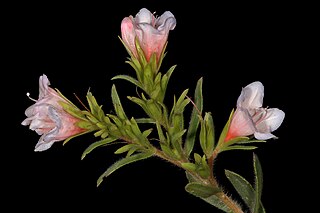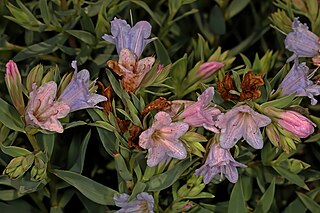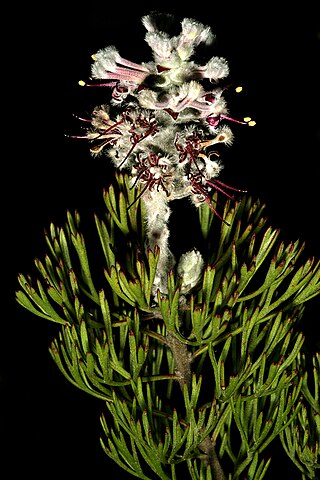
Agapanthus africanus, or the African lily, is a flowering plant from the genus Agapanthus found only on rocky sandstone slopes of the winter rainfall fynbos from the Cape Peninsula to Swellendam. It is also known as the lily-of-the-Nile in spite of only occurring in South Africa.

Fynbos is a small belt of natural shrubland or heathland vegetation located in the Western Cape and Eastern Cape provinces of South Africa. This area is predominantly coastal and mountainous, with a Mediterranean climate and rainy winters. The fynbos ecoregion is within the Mediterranean forests, woodlands, and scrub biome. In fields related to biogeography, fynbos is known for its exceptional degree of biodiversity and endemism, consisting of about 80% species of the Cape floral kingdom, where nearly 6,000 of them are endemic. This land continues to face severe human-caused threats, but due to the many economic uses of the fynbos, conservation efforts are being made to help restore it.

Erica abietina is a species of erica that is endemic to the Cape Peninsula of the Western Cape, South Africa. E. abietina includes four subspecies with often highly restricted distributions and distinctive flower colours. Previous delimitation of the species has included a further three subspecies which proved to be more distantly related to Cape Peninsula endemic E. abietina subspecies and are now classified under Erica grandiflora L.f. and Erica situshiemalis E.G.H.Oliv. & Pirie.

Erica baccans, the berry heath, is a species of Erica that was naturally restricted to the city of Cape Town, South Africa.

Acrodon is a genus of ice plants from South Africa. It comprises five species, mostly endangered and all restricted to the southern Cape regions of the Western Cape and Eastern Cape Provinces, South Africa.

Lobostemon is a genus of flowering plants belonging to the family Boraginaceae. It is endemic to the Cape Provinces of South Africa. The majority of species are limited to the winter rainfall area of the country, from Springbok to Mossel Bay. In Afrikaans these species are known as agtdaegeneesbos, or loosely translated, bush that will heal in eight days. As this name suggests, many species have medicinal properties. This is best known from Lobostemon fruticosus, which is used for treating wounds, blood poisoning, ringworm, skin diseases and syphilis.

Lobostemon montanus, the turquoise bush bugloss, mountain lobostemon or agtdaegeneesbos, is a South African species belonging to the forget-me-not family.

Lobostemon argenteus, or the silver healthbush, blue rocket bugloss or disselblaarluibos, is a species in the forget-me-not family that is endemic to South Africa.

Lobostemon belliformis, the Gouriqua lobostemon or beaut healthbush, is a critically endangered species in the forget-me-not family. It is known from a single locality on the Riversdale Plain in South Africa.

Lobostemon capitatus is a species belonging to the forget-me-not family. It is endemic to the Western Cape of South Africa, where it is found between Porterville and Bredasdorp.
Lobostemon collinus, the pyjamabush or iron healthbush, is a species belonging to the forget me not family. It is known only from the fynbos biome of the Western Cape of South Africa.
Lobostemon daltonii, the Infanta healthbush, is a species of the forget-me-not family endemic to the Cape Provinces of South Africa.
Lobostemon decorus, the Rooiberg healthbush, is a species belonging to the forget-me-not family. It is endemic to the Western Cape of South Africa.
Lobostemon echioides, the common healthbush, is the mostly widely distributed species in its genus. It is endemic to the Cape Provinces of South Africa, where it is found growing between Namaqualand and the Karoo and the Eastern Cape.

Lobostemon fruticosus, also known as the eightday healthbush or pyjamabush, is a species of medicinal plant endemic to the Cape Provinces of South Africa. It is considered to be ecologically and economically important but is declining due to overexploitation.
Lobostemon glaber, the renoster healthbush, is a species of plant from South Africa. It is in the forget-me not family.

Lobostemon glaucophyllus, the smooth-leaved bush bugloss or grey healthbush, is a South African plant species belonging to the forget-me-not family. It is endemic to South Africa's Cape Provinces.

Paranomus bolusii, the Overberg sceptre or viking sceptre, is a flower-bearing shrub that belongs to the genus Paranomus and forms part of the fynbos. The plant is native to the Western Cape, South Africa.
Acrodon parvifolius, the Botriver tiptoothfig, is a species of mesemb from South Africa. This species, which grows close to the ground, can best be recognised by its small, thin leaves and its flowers, which form a dome in the middle.
Acrodon subulatus, the Overberg tiptoothfig, is a species of mesemb from South Africa.













